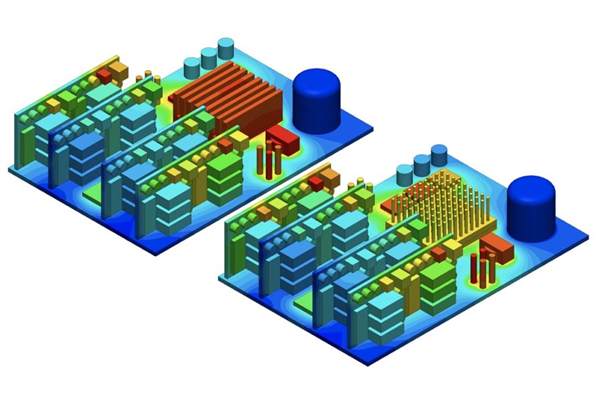Introduction
Let’s talk about something cool – not ice cream, but heat sinks! In electric cars, these are like super fans that keep things from getting too hot. Just like you need a fan on a hot day, electric car parts, like batteries and motors, can get too hot. That’s where heat sinks come in. Think of them as special helpers that stop things from getting too toasty.
This blog will show you how these helpers are put in electric cars to handle all the heat that strong parts make. We’ll learn why stopping things from getting too hot is important, how heat sinks do their job, and why they’re like the secret heroes of electric cars.

Understanding Thermal Management in EVS
Picture your phone getting warm after using it for a while because electronics produce heat. Imagine an electric car with big batteries, motors, and gadgets. All these parts create even more heat. This heat can be a problem, like when your phone slows down.
In electric cars, it’s a bigger concern. Thermal management in elecric vehicles is like giving these parts a cool breeze so they don’t get too hot and work their best. Just as you need to stay comfy, electric cars must stay cool. This helps them run well, last longer and keeps you safe on the road.
Heat Sink Basics
Alright, let’s break down heat sink basics! Imagine a superhero cape for your computer or car parts. Heat sinks are like those capes but for electronics. When things work hard, they heat up – like a phone after playing games. Heat sinks, usually made of metal, grab this heat and spread it out so it cools down faster.
The metal’s like a heat magnet, pulling warmth away. Think of it as a friend keeping you cool on a hot day. In cars and gadgets, heat sinks ensure things don’t get too hot and keep everything running smoothly.
Importance of Heat Sink Integration
Heat sink integration is like teamwork for electronics. Just like a puzzle piece fits perfectly, heat sinks are placed in gadgets and cars to match the hot spots. Their job? To stop things from getting too hot and causing problems.
Think of it as having a fan in your room – it keeps you comfy. Heat sink integration is crucial because it helps gadgets and cars stay safe, work well, and last longer. Without it, parts could slow down or even break! So, just like friends helping each other, heat sink integration helps things stay cool and in great shape.

Components Requiring Heat Sink Integration
Some parts in electronics and cars are like hotspots at a party – they generate lots of heat! These party-loving components include batteries, power gadgets (like converters and motors), and electric motors. They’re like the engines of a car, working hard to make things move. But with hard work comes heat, and too much heat is a problem.
That’s where heat sink integration steps in. It’s like giving them a cool drink to stay comfortable. Adding special cooling parts ensures these important components don’t overheat, keeping everything running smoothly and avoiding any issues.
Factors Influencing Heat Sink Design
Designing a cool superhero suit like Iron Man’s needs careful planning. The heat sink design is similar. It depends on a few things. First, how much heat the gadget or car part makes – like how hard you play a game on your phone. Second, how much space is available – just like fitting clothes.
Lastly, the way we cool down – using fans or cool liquids. So, just as Iron Man’s suit fits his needs, heat sinks are designed to match the heat, space, and cooling style, ensuring everything stays comfy and works perfectly.
Strategies for Effective Heat Sink Integration
Imagine a jigsaw puzzle coming together – that’s how heat sink integration works! To keep gadgets and cars cool, we use smart tricks. Placing things in the right spot, like a fan near a hot laptop, lets air flow easily. Also, using special goo (thermal paste) helps heat spread evenly.
Just like sunscreen protects your skin. These tricks shield parts from overheating. And remember, it’s not just about staying cool – it’s about teamwork between design and cooling methods, making sure all the pieces fit snugly and everything runs smoothly without getting too hot.
Cooling Mechanisms and Their Integration
Cooling mechanisms are like superheroes keeping things chilly. Imagine a fan cooling you on a hot day – that’s air cooling. It’s like a breeze for gadgets too. Liquid cooling is another trick, like icy water running through a car’s veins. For some gadgets, it’s a mix of both – like an air conditioner and a fan working together.
These cooling friends are integrated into gadgets and cars, ensuring things stay cosy. Like wearing a hat on a sunny day, cooling mechanisms shield components from overheating, helping them perform well and last longer.
Battery Thermal Management
Think of an electric car’s battery like a phone battery – it can get warm during heavy use. Battery thermal management is like giving it a cool drink. In electric cars, big batteries make a lot of heat. If they get too hot, they can’t work well and might get damaged. That’s where special cooling comes in.
It’s like a mini AC for the battery, ensuring it’s not too hot or cold. Like you feel best in a comfy temperature, batteries work best when they’re not too hot or chilly, thanks to battery thermal management.
Thermal Management System (TMS)
Ever wished your room had a thermostat that kept it just right? A Thermal Management System (TMS) does that for cars and gadgets. It’s like a smart friend that checks if things are getting too hot. When parts start warming up, the TMS steps in, adjusting fans or cooling liquids to keep them cool. It’s like magic – but really, it’s science! As you’d drink water when you’re hot, TMS ensures gadgets and cars don’t get overheated. So, thanks to TMS, everything stays comfy, works smoothly, and stays safe from too much heat.

Regenerative Braking Heat Management
Imagine a bike that charges your phone as you pedal – that’s regenerative braking in cars. When you hit the brakes, it creates heat, like rubbing your hands together. Regenerative Braking Heat Management keeps this heat in check, like not letting your hands get too hot. Special systems cool down the brakes so they don’t get too warm and work well.
It’s like giving the brakes a break! This way, the car stays safe, and braking stays effective. Regenerative braking heat management is like a cooling superhero for your car’s brakes, ensuring they’re always ready to stop when needed.
Future Trends and Innovations
The future of cars and gadgets is super exciting! Imagine cars that talk to each other, like friends chatting on phones. Future trends bring cooler ways to keep things comfy – like clothes that adjust to your body temperature. Technology will get even smarter in cars, helping with parking and driving safely.
Innovations will make gadgets and cars use energy better, like your phone last longer. Imagine cars charging as they drive – that’s coming too! So, buckle up for a ride into the future, where cars and gadgets become even cooler, smarter, and friendlier to the environment.
Conclusion
Ever wondered how your phone stays cool even when you use it for hours? Electric cars face a similar challenge but on a much larger scale. Welcome to the world of “Heat Sink Integration in Automotive Electronics.” Imagine your car’s important parts, like its brain and muscles, getting hot from all the energy they use. Heat sink integration is like giving them a cooling superhero cape. In this journey, we’ll explore how these special capes tackle the heat and keep electric cars running smoothly and efficiently.
